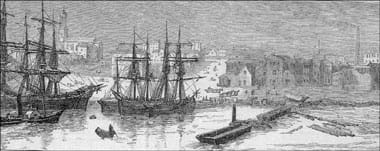
Standing on Port Melbourne pier among the large ships of today it seems
incredible that in 1846 the great grandfather of two of the older present
day vegetable growers disembarked from a small ship not far from
here.
In his pocket was a letter from his brother who had arrived in
the colony in 1842, and who had chosen ten acres of land for which
he paid £5 an acre.
In that letter were directions to enable him to find the property.
He
was told to walk so many miles south along the coast line, then turn
due east for a further number of miles, and he would arrive at the block
of land. He followed his brother’s instructions and arrived at what is
now the corner of Tucker and Patterson Roads, Moorabbin.
What a task, when one considers that the only way to measure each mile
was to count the number of paces. To keep a record of the miles walked
he placed a piece of twig in his pocket at the end of each mile until
the given number of miles had been travelled.
The early growers
Of course these brothers were not the first vegetable
growers. Small lots were already grown at Emerald Hill, now South Melbourne.
In December, 1836, the population of the Port Phillip settlement
was 224, and by December, 1840, it had reached 10,291. At that time the
emphasis was on growing grain and vines, with a view to exporting to
England. Grapes were growing at South Yarra, Prahran and Hawthorn.
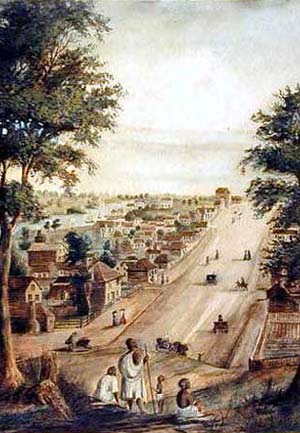 By 1844 the population had risen to 26,734 and the demand for products from By 1844 the population had risen to 26,734 and the demand for products from
the land began to increase. Farmers had moved to Brighton, which included
all the surrounding area for many miles. Orchards and vineyards were
planted, oats, wheat, grazing, dairying and vegetable growing became
established.
1845 saw the punt over the Yarra replaced by a wooden bridge, simplifying
the river crossing for horse vehicles. Gradually the different types
of farming moved to more suitable areas, but vegetable growing remained
in the sandy loam area until a few years ago, when increasing land prices
caused a move in a south-easterly direction.
To reach Melbourne from Cheltenham and the outlying Brighton area one
had to walk to Brighton, where transport to Melbourne was available.
Needless to say Aborigines were often seen and spoken to by the early
settlers who had to make such walks.
Hard going
Market trading was done in the early hours of the morning, so to be there
in time vegetable growers had to travel overnight and return to their
farms the following afternoon.
In the early years growers carted their produce by horse and dray over
roads or bush tracks often so rough that the drivers had to walk ahead
with lanterns to find the holes and fill them in so the load could get
through. Many times the going was so tough that an extra horse was needed
to haul the load up steep rises or through loose patches.
When the bad patches had been negotiated the extra horse was unhitched,
turned towards home, given a pat on the rump and sent on its way. If
the horse was new to the road it was taken home by the wife or one of
the children who had accompanied the load. The going was hard enough
but when they reached the better road, now Point Nepean Highway, a toll
had to be paid before they could travel on that road.
Toll gates
A toll was collected at two points, one on entering the main road on the
way to Melbourne, the other at a point near the Shrine of Remembrance
on the return trip. A son of the early Cheltenham pioneer mentioned left
home with a dray load of cabbages for Eastern Market. On arrival at the
toll gate the only money he had was a sixpenny coin on a watch chain
which was accepted by the collector.
It turned out to be one of those markets where cabbage were unsaleable.
The load was finally sold and delivered to a dairy farmer in Fitzroy
for sixpence a dozen. This family still has the iron plough that turned
the first sod in the Cheltenham district.
Roads were gradually improved. Many of the older growers still remember
the steel plates that were laid in Point Nepean, Centre, South, and Centre
Dandenong Roads, which they said gave them an armchair ride and made
the lot of the horse much easier. In fact there is still a section of
these steel plates in Centre Dandenong Road opposite the Moorabbin Airport.
Markets
The first fruit and vegetable market was established
in 1841, four years before the wooden bridge was erected over the Yarra
to replace the punt which crossed near the present Princes Bridge. It
became known as the Western Market and was situated in Market Street.
Eight leading citizens were elected by householders as Market Commissioners
to control the market. In the year 1842 Melbourne was incorporated as
a town and authority to conduct the market was transferred to the Melbourne
Town Council.
Following a fire at the Western Market in 1853, the fruit and vegetable
growers’ section was transferred to the Eastern Market in Exhibition
Street where growers sold their produce until 1878. The growers’ section
of the Eastern Market was transferred to the Queen Victoria Market in
1878.
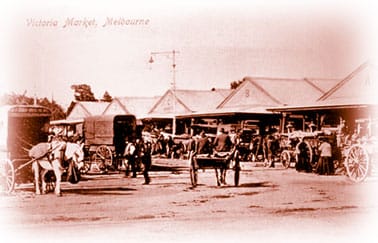 After rebuilding, the Western Market continued as the merchants’ section After rebuilding, the Western Market continued as the merchants’ section
of the Wholesale Fruit and Vegetable Market until being transferred to
the Queen Victoria Market site in 1930.
Clearing and draining
When the pioneers first saw their land it was thickly covered with eucalypts,
wattle, banksia, ti-tree, wild cherry and many other smaller native species.
Some areas were almost impenetrable. Those who ventured into these forests
in which possums, native cats and snakes were plentiful had to mark trees
with an axe to enable them to find their way out again.
Clearing was done by hand with such aids as the axe, pick and shovel.
At first the timber had no value other than for building houses, sheds,
fences and drains. In later years the timber was cut into firewood and
carted to the Balaclava area where it was hawked around the homes.
Carters
wanted 12 shillings a load, but sales were not easy. They were mostly
offered ten shillings for a load but would hold out for twelve. When
they decided that they could not get their price, they would go to a
paddock or common, where St. Kilda Town Hall now stands, tip off the
load, restack it over a hollow centre and return to accept ten shillings
for it.
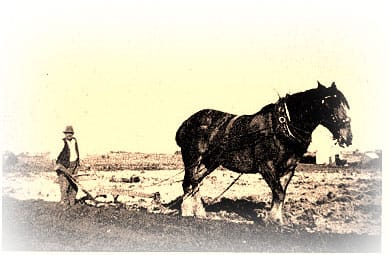 After clearing, the land was broken up with an iron plough drawn by two After clearing, the land was broken up with an iron plough drawn by two
horses. After further ploughing and harrowing the ground was ready
for cropping.
When time and labor were available the ground was drained
by digging to a depth of two or three feet, placing six to twelve
inches of timber or ti-tree in the bottom then filling in again.
Manures
The manure and fertiliser used was fairly well balanced. Stable manure
supplied nitrogen, potash and organic material. Blood manure was
a source of nitrogen and bone dust supplied the phosphate and calcium.
Transport
As the roads improved so the vehicles changed and gradually became larger.
The dray which was a high wheeled, springless and almost unbreakable
thing gave way to the spring dray, a lighter version with springs attached
between the axle and the body. This in turn gave way to the four
wheeled wagon with fixed sides and drawn by either one or two horses.
Further road improvement saw the end of high wheeled vehicles. The lorry
having four small wheels and moveable sides, supplanted the other types
and enabled carting of larger loads, although still small by today’s
standards. Although the vehicles changed in type and size, the horse
was still the means of pulling them.
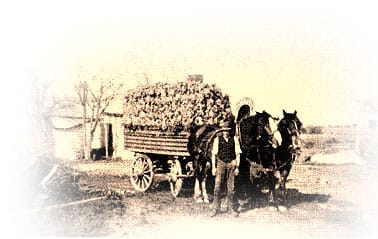 Many of the old timers still love the horse and tell stories of just Many of the old timers still love the horse and tell stories of just
how important it was for them to have good strong animals. Their survival
depended on it.
In fact, the horse always had pride of place on the farm. Gardeners were
often judged by the horses they kept and this is reflected in an old
saying, ‘If you can’t keep a good horse in good condition, you are
no damn good yourself.
The discovery of gold brought not only prosperity but problems to the
industry. By 1852 the population was 168,321, but by 1859 it had increased
to 521,072.
Such a rapid increase caused a heavy demand for vegetables
and prices rose fantastically. Before gold was found, wages were three
to four shillings a day or ten shillings a week and keep. But when laborers
and some growers decided to try their luck with the pick and shovel,
labor became scarce.
Competition for labor pushed wages up to 18 to 20
shillings a day. The Melbourne and Metropolitan Board of Works was forced
to pay stonemasons 21 shillings a day to enable the Yan Yean reservoir
to be completed in 1857.
Vegetable prices showed a similar story. Prices of cauliflowers
and cabbages rose from sixpence to 24 shillings a dozen, carrots from
twopence to 2 shillings a dozen bunches, and potatoes from £2 to £150
a ton. One farmer tried to grow potatoes nearer the mining towns. He
paid £10 a bag for 40 bags to use as seed.
The following year was
very dry and not one bag of potatoes was harvested. That year saw chaff
make £160 a ton. Gold became scarcer by 1870 and people began to
drift away from the gold fields to take up land in Mordialloc, Mentone,
Heatherton, Dandenong, Burwood and Doncaster.
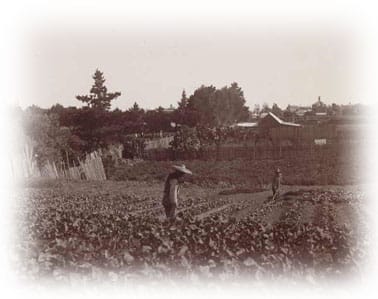 At the same time many Chinese left the gold fields to begin vegetable At the same time many Chinese left the gold fields to begin vegetable
growing. They took up land on creek or river flats around Melbourne,
as well as in the eastern part of the Brighton district.
The last community
of Chinese vegetable growers in that area was in Mackie Road, Bentleigh
about 1920.
The early 1890s saw the bottom fall out of everything. The easy money
from gold ceased to flow, the land boom crashed and banks closed their
doors.
The country was plunged into depression. More and more people
tried to eke out a living by growing a few vegetables or milking a few
cows.
Men who had taken up gardening just before the crash found it very difficult
to hang on. They had bought on a high market and were forced by adverse
circumstances to sell on low markets. In many cases the older, established
grower helped the beginner, or battler as he was called, by giving him
seed potatoes, helping to sow a crop or lending equipment.
Quite a few
still tell of how they were given help from which they never looked back.
There were also other established growers who rubbed their hands in glee
and said ‘I will soon have that paddock’ when they saw a battler in trouble.
Vegetables were plentiful but few people had money to buy them because
wages were so low and hundreds had no work at all. The following prices
tell their own story. Potatoes 15/- to £3 a ton, onions unsaleable
to £3 a ton, jam melons 7/6 to £1 a ton, cauliflowers and
cabbage 6d to 3/- a dozen, lettuce 6d to 1/- a dozen, peas 1d to 3d a
lb, carrots and parsnips 2d to 8d a dozen bunches, swedes and turnips
3d a dozen bunches, tomatoes 3d to 2/- a bushel case.
Wages for skilled
laborers were four shillings a day or ten shillings a week and keep.
Stable manure could be had for the carting, in fact, from 2/6 to 10/-
was often paid to growers to cart it away. Chaff £2 to £3
a ton. Blood manure was £3 a ton, bone dust £4 a ton; potatoes
were dug and onions trimmed for 4d a bag.
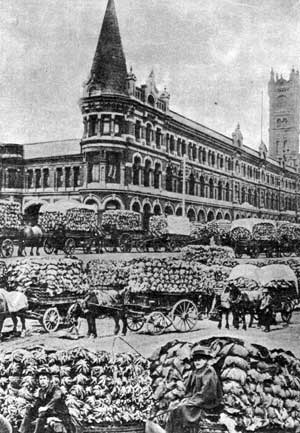 Water supply and usage Water supply and usage
The
Yan Yean reservoir was completed bythe newly formed MMBW in 1857 but
little, if any, of that water was
used by vegetable growers.
It was not until about 1920 when more water
became available from storages in the high areas east of Melbourne that
irrigation became possible in market gardens.
In 1880 growers in the Brighton district had to cart water long distances
from stand pipes near Brighton to save the seedlings of cabbage and cauliflower.
After strong agitation by farmers and vegetable growers the water main
was extended to South Road, but again water was only available from stand
pipes at fourpence for 200 gallons.
The first record of irrigation was from the Keilor plains where Mr. David
Milburn, who had arrived from Yorkshire in 1853, installed three hydraulic
pumps, each capable of lifting 50 gallons a minute to a height of 50ft,
to water his 115 acres of fruit and vegetables from the Maribyrnong River.
When reticulated water became available, some 50 to 60 years ago, growers
found that by using it judiciously they could spread their planting season
over much longer periods.
Transplanting became easier, seed could be
sown irrespective of rainfall, two crops could be taken from the one
area each year and there was an improvement in quantity and quality.
Survival of the fittest
The period between 1890 and 1910 really put growers on their
metal. Times were hard and in many cases survival depended on their own
efforts. In those days vegetable growers often kept a few cows and poultry.
1896 was a year when vegetables were almost unsaleable, particularly
cabbages which formed the major part of the crop in the Cheltenham district.
One grower had as much as six acres, others smaller areas. They all had
a cow or two, so they decided to start a butter factory. More cows were purchased and
fed on the unsaleable vegetables. A creamery was erected
in Centre Dandenong Road, east of Warrigal Road, where butter was made
under the brand name ‘Gilt Edge’.
Cutting the butter into one pound pats was a problem until one of the
chaps invented the first butter cutter, a series of wires which became
known as the ‘Invicta Butter Cutter’. The old building is still standing,
it is the one blocking the service road on the south side of Centre Dandenong
Road.
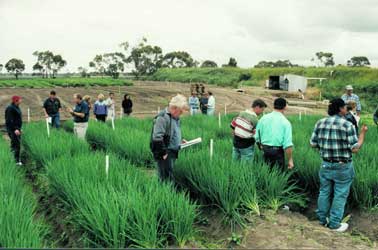 Legacy Legacy
The most important legacy handed down from the early vegetable
growers is the narrow raised bed of land which is common practice throughout
the industry today. The origin of the narrow bed, I am told, arose out
of desperation.
The old system was a bed 12ft wide on which four rows
of cabbage or cauliflower were grown. One very wet year the whole district
was water-logged and all crops were at a stand-still.
In desperation one cauliflower grower ploughed a furrow between every
second and third row of plants. Those extra furrows helped to take away
the excess water more freely, the crop recovered, and quite fair quality
cauliflower were marketed.
Seeing is believing
This move did not go unnoticed by other
growers who were quick to copy the example.
So began the narrow seed bed which is the reason why Victoria is able
to produce vegetables throughout the year, even in the wettest year.
Early vegetable growers sold mostly on a buyers’ market. Occasionally
however supplies were short and the advantage then went to the seller.
They were proud of the industry which they had developed. They sold in
open competition with each other, always striving to produce something
better than the opposition.
Growers began a tireless search for improvement in varieties and in production
methods. They had to grow without water and above all they had to win
out. They developed powers of observation that helped to overcome
many problems.
It was largely due to that competitive spirit and independence that
they formed an association to handle their own produce for the Sydney
market in the early 1900s. It was also that accumulated knowhow and drive
that enabled them in 1941 to increase their output for both overseas
forces and home consumption.
Such is the beginning from which the majority of the present day growers
came a group of hard working, self-reliant men who achieved what
they set out to achieve with little assistance and no subsidy.
|